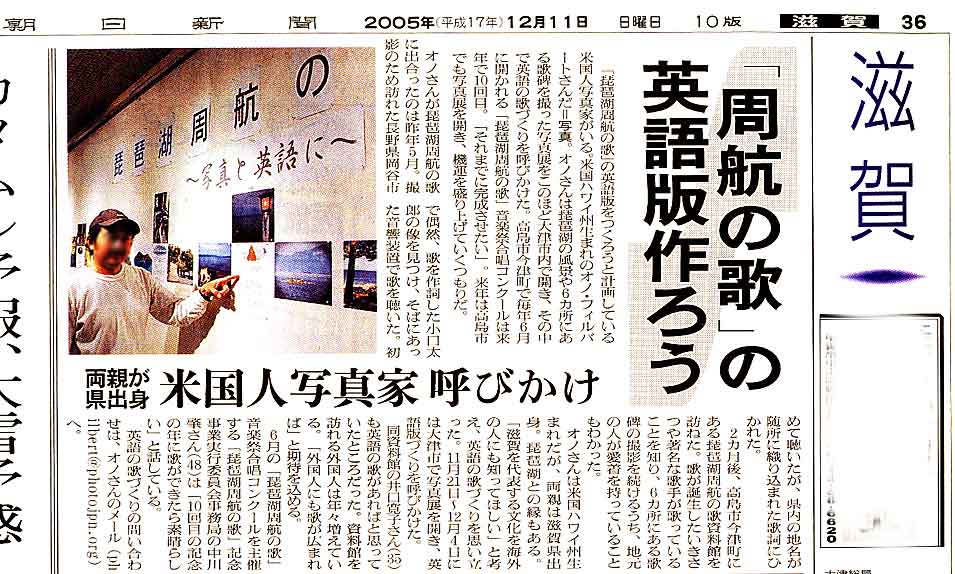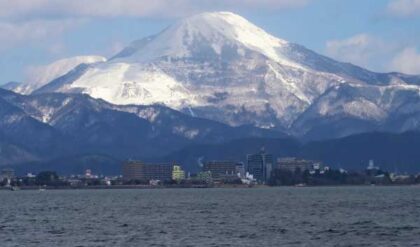
I will hold a small photo exhibition in Otsu, Shiga Prefecture to show pictures of Lake Biwa based on the well-known song, “Biwako Shuko no Uta” or Lake Biwa Boating Song.(琵琶湖周航の歌)
Made famous by singer Tokiko Kato in 1971, the song is about a bunch of Kyoto University college students in the college boating club in 1917 who rowed in a sleek, wooden racing boat around Lake Biwa starting at Otsu and stopping overnight at Omi-Maiko, Imazu, and Hikone before returning to Otsu. It was the boat club’s tradition to row around the entire lake every summer.
The song mentions famous places in Lake Biwa and also symbolizes life itself. The song was written by Taro Oguchi (1897-1924), a member of the boating club and native of Okaya, Nagano Prefecture. The melody was based on a song called Water Lilies (Hitsuji-kusa) by Chiaki Yoshida (1895-1919) from Niigata Pref. who never knew that his melody was used for the song.
It was during the second night of their boating trip in June 1917 in Imazu, in the northwest corner of Lake Biwa, when Oguchi first showed his lyrics to his boatmates. One boatmate suggested that the Water Lilies melody went well with the lyrics, so it stuck and they sang the song together for the first time, even while rowing on the lake.
It’s sad that both Oguchi and Yoshida died in their early 20s. Both were extremely talented and would’ve accomplished much if they had lived longer. The song has a very intriguing mystique. Some of the words are incomprehensible, doesn’t make sense, or just plain wrong. It was not a seriously written song.
It nonetheless went on to become very popular in Japan and many famous singers like Peggy Hayama, Miyako Harumi, Frank Nagai, and Kobayashi Akira have covered it. Nini Rosso even played a trumpet version.
The town of Imazu even has a nice museum dedicated to the song. It points out all the mistakes and mysteries of the song, but does not shed much light on all the questions. There’s a listening corner where you can don headphones and listen to all the cover versions of the song (it can take at least an hour). The town also holds an annual choir singing contest in June for that song. Choir groups from around the country enter the contest just to sing that song.
Also, Shiga Prefecture has six monuments dedicated to this song. Each one is dedicated to one of the six verses of the song covering the following six places: Otsu (Mihogasaki), Omi-Maiko, Imazu, Chikubushima, Hikone, and Chomeiji. The song monument in Hikone (for verse No. 5) was recently unveiled in Oct. 2005. And the city of Okaya in Nagano Prefecture also has a monument for the song and its composer, Taro Oguchi, a native of Okaya.
The mysterious meaning of the lyrics, the way it was created, the story behind the people who created it, the nostalgic reflection of a certain time and place in the past, and its national fame all combine to make it a very interesting song to study.
I had never even heard of it (it was before my time) until last year in April 2004 when I was in Suwa, Nagano to see the Onbashira Festival. I stayed in Okaya city on the shores of Lake Suwa. I walked around the lake and came across a statue of Taro Oguchi. It even had a sound box where you could hear the song. The lyrics were also displayed and I immediately found it intriguing.
For this exhibition, I have created my own photographic rendition of the places and scenes mentioned in the song and the six monuments dedicated to the song. I used Photoshop to composite images and to alter the colors into a dreamy condition as the song suggests. I also translated the lyrics into English. Call it “Lake Biwa Boating Song in Pictures and in English.”
Place: Shiga Kaikan Bunka Salon Gallery (滋賀会館文化サロンギャラリー)
5-min. walk from JR Otsu Station.
Map: http://www.shiga-bunshin.or.jp/shigakaikan/map.html
Address: Kyomachi 3-4-22, Otsu, Shiga Pref.
Phone: 077-525-9995
〒520-0044 大津市京町三丁目 4-22
Web site: http://www.shiga-bunshin.or.jp/shigakaikan/
Date & Time: Nov. 21 to Dec. 4, 2005, 9:30 am to 5:00 pm, closed Mon.
The gallery is actually inside a salon-type coffee shop. It’s a nice space (see image below).
Update: I now have an online version of the exhibition:
https://photoguide.jp/pix/thumbnails.php?album=155
And video here:
Lake Biwa Rowing Song music video





